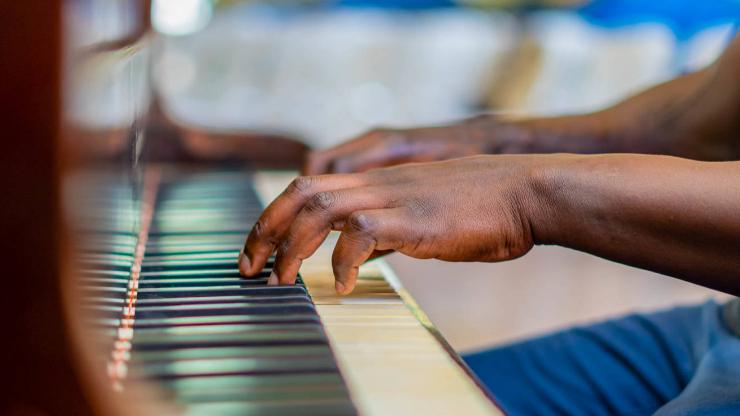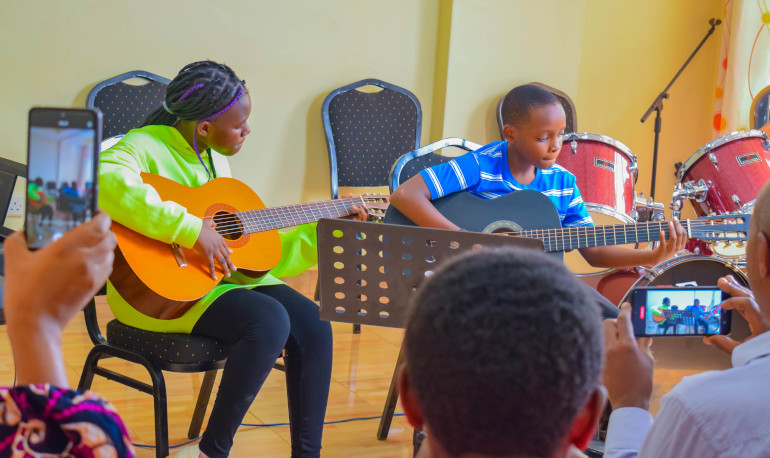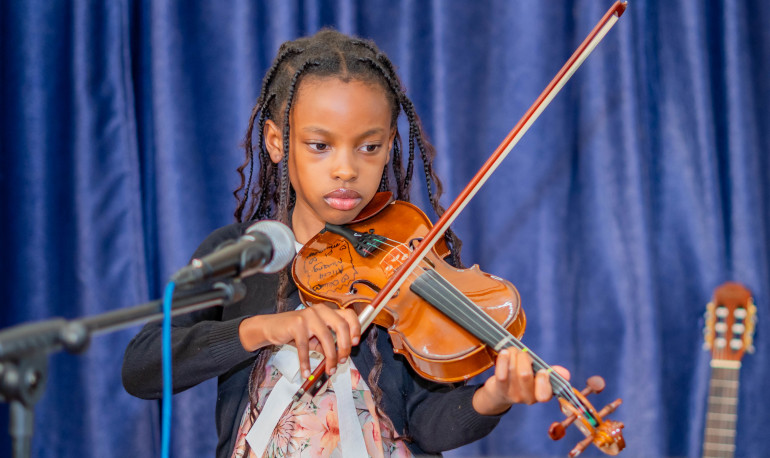Developing Muscle Memory for Instrumental Mastery : The Science of Performance
Cheza Music
Aug 1, 2022 at 9:34 am
0 Comments

This article provides guidance and insights on how to improve your musical performance skills, particularly if you are learning a musical instrument. It discusses the concept of muscle memory, which is essential for mastering an instrument, and explains how to harness this memory for better musical performance.
If you're learning a musical instrument, performance is probably your goal. Statistics show that the reason most people drop out of instrumental classes is that they don't get to the level of performance.
If you're learning a musical instrument and you want to be a good performer, this is for you.
After several interviews with professional performers, doing research on the neuroscience concerning performance memory, and reading a number of books on habit formation, I came up with a teaching method that makes performance possible for all who attempt to learn a musical instrument.
I have personally tried the technique explained in this article with several students, to my satisfaction.
I have confidence, beyond any reasonable doubt, that this will work for you if you put to practice the information shared in this article.
This will help you if:
- You take too long to learn a piece
- You have breaks in your performance
- You have to start over when you miss a note in the performance
- It takes a lot of effort to learn a piece
- You've learned your instrument for more than 3 months and you've never performed
Of importance in this article, is the ability of our muscles to remember movements in performance, and how to utilize this great power for our advantage.
**Muscle Memory**
Muscle memory refers to the ability of our muscles to remember and repeat a series of actions or movements without conscious thought or effort.
Also referred to as motor learning, it plays a crucial role in playing any musical instrument.
In different occupations, muscle memory plays a very vital role.
Think of a carpenter hammering nails into wood, a Rubik's cube master in action, or a touch typist at work.
They rely on muscle memory to focus on more important details of their work.
The same is true for musical instrument mastery.
Virtuosos perform almost entirely from muscle memory.
Their performances are a result of many hours spent with their instruments.
When learning a piece for the first time, you think about every single note, every rhythm pattern, phrasing, dynamics, and so on.
With more practice, neural pathways start forming in your brain so that you don't actively think of each note; the involved muscles start to move on their own.
The purpose of this article is to show you how to make the process (of developing muscle memory) easier, faster, and more fulfilling.
Since muscle memory allows you to play the piece with accuracy, fluency, and less effort, you will no longer need to think consciously about each note and finger movement.
The power behind this is the ability to now express your music just as you would express yourself in a familiar language.
**So, how do you embrace the power of muscle memory and play with prowess? Here are some things to know:**
**Chunking**
This is one of the most important techniques that muscle memory depends on. Without it, habit formation is quite difficult.
Chunking is an effective technique for developing strong muscle memory in music. It involves breaking down a larger piece of music into smaller, more manageable sections.
The shorter a task is, the easier it is for your brain to correct mistakes and create accurate neural pathways.
Here are some steps you can follow to chunk a music piece effectively and develop strong muscle memory:
1. **Listen:** Take time and listen to the music in its entirety several times. Get the structure and identify natural breaking points or phrases. Mark your score accordingly so that you will remember your intentions during practice. You may also need to mark out sections that sound difficult and study the score to see what's happening in those sections.
2. **Break it into sections:** Using either chord progressions or phrases, break the piece into logical sections. Be careful of phrases. Although each chunk may be far less than a phrase, it is important to know how your phrases are structured. For anacrusic pieces, phrases may end between bars, for example.
3. **Practice each section separately:** Once the piece is split into sections/chunks, learn each chunk until you can play without making mistakes. The practice involves repetition. Start each section slowly to get a correct rhythm, fingering, and other techniques. Using a metronome, work each section up to the desired performance tempo, considering all articulations, dynamics, and other performance directions.
4. **Connect the sections:** There are two or more approaches for connecting sections. The first one is working on the small sections until all the parts are mastered, then connecting the sessions one by one until the piece is completely connected. The second approach is to connect the mastered sections before learning new sections. The first two mastered parts are connected before learning the third one, etc. Whichever approach you take, the result is the same.
5. **Practice regularly:** While connecting the sections/chunks, you will start missing some notes that you had mastered. Connecting the sections is a new task that your brain is starting to learn. Allow your brain to form new neural pathways to connect the existing ones. Although connecting the sections is perceived by the brain as a new task, connecting will take significantly less time than it took to learn the chunks. Once the piece is connected, play through the whole piece regularly. Take note of where you have breaks and work on the breaking sections before connecting the whole piece again. Recording yourself may be very helpful. Watching yourself playing may reveal to you things you hardly notice when you're playing.
**Advantages of Chunking:**
- **Improves memorization:** Chunking helps in memorizing music by breaking it down into smaller segments, which are easier to remember. This way, musicians can learn each segment well and then combine them together to play the entire piece.
- **Increases focus:** By dividing a piece into smaller chunks, musicians can focus on perfecting each section, rather than trying to tackle the entire piece at once. This helps in maintaining focus and concentration during a practice session.
- **Enhances technique:** Chunking allows musicians to focus on specific technical aspects of the music, such as fingering, timing, and phrasing. This can lead to improved technique and greater control over the instrument.
- **Reduces stress:** Chunking reduces the pressure that comes with trying to learn an entire piece at once. By breaking it down into smaller parts, musicians can learn at their own pace, which can help to reduce stress and anxiety.
- **Improves performance:** By mastering each chunk of a piece, musicians can increase their confidence and perform the piece more effectively. This can lead to a more polished and professional-sounding performance.
**Repetition**
When an action is repeated over and over, our brains have a way of teaching our muscles so that the actions are performed without conscious effort.
The basal ganglia are the part of the brain responsible for forming procedural memory we refer to as muscle memory.
This part of the brain controls movement and the learning of new skills.
The neural pathways in the basal ganglia, through a process called synaptic plasticity, take advantage of repetition to increase efficiency in transmitting signals necessary to execute the repeated movements.
This makes it impossible not to become better at something that you do every day.
Synaptic plasticity basically refers to changes in the strength and connectivity of synapses (the connection between neurons).
These changes and connectivity become permanent over time which makes actions easier to perform without conscious effort.
When we perform a movement or action repeatedly, such as playing a particular chord on a guitar, the neural pathways in the basal ganglia become more efficient at transmitting the signals necessary to execute the movement.
This is due to a process called synaptic plasticity, which involves changes in
the strength and connectivity of synapses (the connections between neurons).
Over time, these changes in synaptic strength and connectivity become more permanent, and the movement or action becomes easier to perform without conscious effort.
This is why experienced musicians can play complex pieces of music effortlessly, without having to think about each individual note or movement.
**Building a Repertoire**
The repertoire is a vital requirement for every performer. Performance is the output of any instrumental lessons. Few parents want to know if their child can read music. All they care about is performance. They ask, can my child perform anything?' Of what use is the ability to read music if there's no performance?
Wherever we mention that we can play an instrument, the people around us will most likely ask us to play something for them. They don't care if you learned it by ear or through reading a score. Good thing, either way, the preparation for performance follows the same procedure.
It is for that reason that I address in this article, how to prepare for performance. Performance is rarely a natural outcome of learning to read music. A typical student will have approximately 30 minutes a week with their teacher. The preparation thereof has to be taught. Here is how:
**Understanding Performance**
Any outstanding performance in any instrument leaves people asking how possible it is to perform in such a way, and so effortlessly. What people don't know is that what they're seeing is the tip of the iceberg, the results of a substantial effort. The flawless work was joined together bit by bit, chunk by chunk.
Performance pieces are usually approximately 2 (sometimes 3) grades higher than the sight-reading tests of any instrument. Consequently, a grade 1 piano pupil will be learning performance pieces that they should be able to sightread when they are in grade 4.
If you are like many people, you're wondering about the difference between performance and sightreading. For that reason, I will first differentiate the two. I believe that failure to tell the difference is the greatest reason why most people don't ever realize their full potential in playing an instrument.
**Performance vs. Sightreading**
Performance and sightreading are two distinct skills in the world of music. Understanding the difference between them is crucial for anyone aspiring to become a proficient musician.
**Performance:**
- Performance involves playing a piece of music that you have thoroughly practiced and prepared in advance.
- It often requires memorization of the music or a deep familiarity with the score.
- Performers aim to deliver a polished and expressive rendition of the music, showcasing their musicality and technical prowess.
- Performances are typically given in front of an audience, whether in a concert hall, at an event, or even just for friends and family.
- The goal of a performance is to convey the emotions and intentions of the music to the audience.
**Sightreading:**
- Sightreading, on the other hand, involves playing a piece of music that you have never seen or practiced before.
- Sightreaders rely on their ability to read and interpret sheet music in real-time.
- The emphasis in sightreading is on accuracy and fluency, rather than polished performance.
- Sightreading is a valuable skill for musicians, as it allows them to quickly learn and play new music, whether in rehearsals or during auditions.
- It does not require memorization but rather the ability to read and translate musical notation on the spot.
It's important to recognize that while sightreading and performance are distinct skills, they complement each other. Developing strong performance skills can improve your sightreading abilities and vice versa.
In conclusion, mastering the art of performance requires a combination of effective practice techniques, the development of muscle memory through chunking, and consistent repetition. Building a repertoire of well-prepared pieces is essential for showcasing your musical talents. Understanding the difference between performance and sightreading is also crucial for a well-rounded musical education. By embracing these principles and techniques, you can unlock your full potential as a musician and deliver captivating performances that leave a lasting impression on your audience.
0 Comments
Categories
|
News |
|
Events |
|
Activity |
Popular Courses

Piano Lessons in Nairobi | Learn Piano At Home Course
We provide piano lessons in Nairobi suitable for children aged 4 and above, as well as adults. Our l...

Guitar Lessons In Nairobi | Learn Guitar At Home Course
Our guitar lessons in Nairobi offer progressive lessons for children from 6 years old and ...

Violin Lessons In Nairobi | Learn Violin At Home Course
We provide violin lessons in Nairobi for kids (6 years and older) and adults. Our lessons cover ever...
Working Hours
Depending on individual teachers since we do homeschooling.
© Copyright 2025Privacy Policy | Developer & SEO Services: Josiah Birai (JoeSEO): 0765 356000




Log in to comment